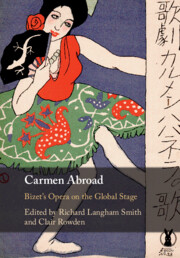Book contents
- Carmen Abroad
- Carmen Abroad
- Copyright page
- Contents
- Figures
- Tables
- Preface
- Acknowledgements
- Notes on Contributors
- Part I Establishment in Paris and the Repertoire
- Part II Across Frontiers
- 7 A New Performance for the New World: Carmen in America
- 8 The Unstoppable March of Time: Carmen, and New Orleans in Transition
- 9 The Return of the Habanera: Carmen’s Early Reception in Latin America
- 10 From Spain to Lusophone Lands: Carmen in Portugal and Brazil
- 11 Carmen in the Antipodes
- 12 Carmen, as Seen and Heard in Victorian Britain
- 13 Celtic Carmens: Rebellion and Redemption
- 14 Carmen for the Czechs and Germans, 1880 to 1945
- 15 Carmen in Poland prior to 1918
- 16 A Woman or a Demon: Carmen in the Late Nineteenth-Century Nordic Countries
- Part III Localising Carmen
- Selected Bibliography
- Index
- References
16 - A Woman or a Demon: Carmen in the Late Nineteenth-Century Nordic Countries
from Part II - Across Frontiers
Published online by Cambridge University Press: 18 September 2020
- Carmen Abroad
- Carmen Abroad
- Copyright page
- Contents
- Figures
- Tables
- Preface
- Acknowledgements
- Notes on Contributors
- Part I Establishment in Paris and the Repertoire
- Part II Across Frontiers
- 7 A New Performance for the New World: Carmen in America
- 8 The Unstoppable March of Time: Carmen, and New Orleans in Transition
- 9 The Return of the Habanera: Carmen’s Early Reception in Latin America
- 10 From Spain to Lusophone Lands: Carmen in Portugal and Brazil
- 11 Carmen in the Antipodes
- 12 Carmen, as Seen and Heard in Victorian Britain
- 13 Celtic Carmens: Rebellion and Redemption
- 14 Carmen for the Czechs and Germans, 1880 to 1945
- 15 Carmen in Poland prior to 1918
- 16 A Woman or a Demon: Carmen in the Late Nineteenth-Century Nordic Countries
- Part III Localising Carmen
- Selected Bibliography
- Index
- References
Summary
Carmen was first given in Stockholm at the Royal Swedish Opera in 1878 just three years after its Parisian premiere. The Swedish Carmen went on tour to Copenhagen and Kristiania, but within thirteen years the opera had been staged with a predominantly local casts also in the other three Nordic countries: Denmark in 1887, Finland in 1889 and Norway in 1891.
The opera arrived in the Nordic countries amidst fierce public debate between idealists and realists arguing about how art should represent woman: as a self-sacrificing and morally high-minded model for the nation-building project (especially in Finland and Norway), or realistically, as a modern troubled woman, such as Nora in Henrik Ibsen’s A Doll’s House.
This chapter examines how the character of Carmen was enacted on the stage and the press reactions to her at this aesthetic and societal turning point of the fin de siècle. I argue, that the singers and critics participated in the ongoing debate about realism, gender equality and modernity. Amidst confusion at a time of aesthetic change, the will to take control of the issues at stake was still rooted in models and strategies from the past.
Keywords
- Type
- Chapter
- Information
- Carmen AbroadBizet's Opera on the Global Stage, pp. 245 - 260Publisher: Cambridge University PressPrint publication year: 2020



